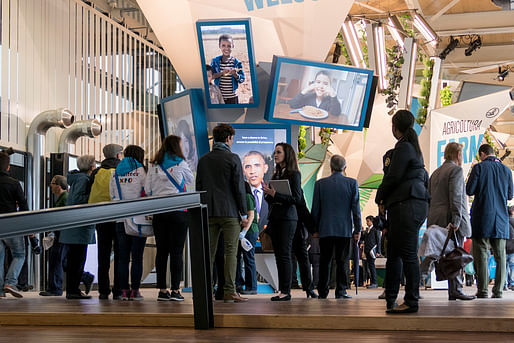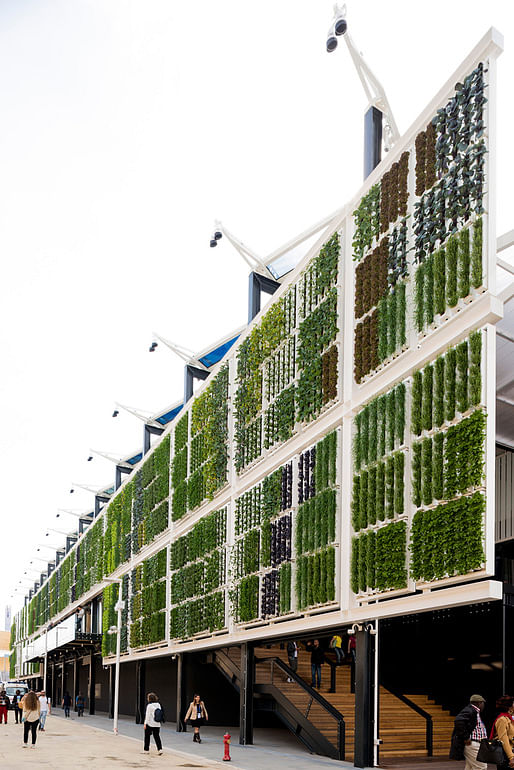
Since breaking ground last summer, the U.S. Pavilion -- titled “American Food 2.0: United to Feed the Planet" -- has opened to the public at the Milan Expo 2015, which is now in its first week. The U.S. joins the more than 140 participating countries that prepared exhibitions and pavilions that respond to the Expo's overall theme of "Feeding the Planet, Energy for Life", which addresses the global issue of food security, access, and the ideal goal to nutritiously feeding more than 9 billion people by 2050.
Designed by New York-based Biber Architects, the pavilion puts on display America's pivotal role in the future of food that emphasizes "openness, transparency and accessibility" in an exhibition designed by Thinc Design. The open barn-inspired structure includes a harvestable hydroponic vertical farm and "uniquely American" (if not consumerist-enticing) features like an expansive boardwalk and a series of food trucks.
Check out photos of the fully constructed pavilion and more details below:

"It is as much a platform for the content embodied in its exhibitions, as it is an exhibit in its own right. According to James Biber, founder and principal of Biber Architects, 'The pavilion itself is a scaffolding for ideas, a rethinking of the nature of the expo pavilion and of America as a force in the food world.'
On one side of the pavilion, visitors are greeted to a subtle reference to Old Glory with a perforated aluminum façade of red, white and blue. On the main pedestrian approach, the pavilion opens its airplane hangar-sized door to another distinctly American, food-related image: the boardwalk."


"Made of salvaged lumber from the Coney Island boardwalk, the walkway rises from the ground level to the second floor, serving as the main forum for self-guided viewing and concealing a defined exhibition space below. On the top floor, a rooftop terrace featuring dimmable glass shade panels will host nightly parties for the rooftop-craving Italian crowds while also catering to VIPs and diplomats."


"The main architectural feature is a motorized vertical farm – the length of a football field – flanking one side of the pavilion. Conceived as a farm field tipped vertically to act as a didactic display, the architects chose ZipGrow Towers, developed by American agricultural technology start-up Bright Agrotech, to outfit the 7,000-square-foot hydroponic façade.
Using 4’ modules made of recycled soda bottles, 42 varieties of crops including green vegetables, fruiting vegetables, grains and herbs will be sustained in soil plugs and a drip irrigation system and harvested every two weeks during the exposition."


"One of the central programs of the USA Pavilion will be Food Truck Nation, a series of food trucks that highlight America’s street food culture while referencing the nation’s diversity, entrepreneurial spirit, and fascination with the road."


The Milan Expo will be open until October 2015.
Photo Credit: Saverio Lombardi Vallauri
Previously:
4 Comments
What's wrong with American Food 1.0, SPAM? Delicious.
This pavilion is a less annoying version of the PS1 current agenda: Eco concept without the annoying formalism. But the result is nice like a well designed Starbucks is nice... It was designed by a branding co not architecture and it shows. Still there are other directions which could have worked. Certainly captures what the mood is.. A clear fetishization of concept into signage.
vertical farm - check
folded objects - check
garage door - check
feature wall signage - check
shipping containers - check
solar panels - check
trees in planters - check
roof deck - check
... 3rd yr studio project?
Lightperson, dead on critique!
" nice like a well designed Starbucks is nice"
Yes Lightperson, I am really missing the phenomenology of the space which could be achieved by the juxtaposition of various architectonic elements...pfft! Who gives a fuck what we think, as everyone knows the US is about corporate power. In that way it succeeds immensely.
Block this user
Are you sure you want to block this user and hide all related comments throughout the site?
Archinect
This is your first comment on Archinect. Your comment will be visible once approved.